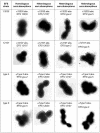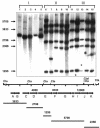Serological and genetic diversity of capsular polysaccharides in Enterococcus faecalis
- PMID: 15184433
- PMCID: PMC427887
- DOI: 10.1128/JCM.42.6.2548-2557.2004
Serological and genetic diversity of capsular polysaccharides in Enterococcus faecalis
Abstract
Enterococci possess capsular carbohydrate antigens that are targets of opsonic antibodies. These antigens may be used to develop alternative options for the treatment and prevention of enterococcal infections. The present study was done to analyze the diversity of capsular polysaccharides in Enterococcus faecalis. Four type-specific sera were used in an enzyme-linked immunosorbent assay format to detect polysaccharide antigen extracted from bacterial cell walls. A total of 55% of a collection of 29 E. faecalis strains could be grouped into one of four serogroups. Additional analysis of the strains by opsonophagocytic assays revealed agreement between the results of the two methods for 72% of the isolates. An additional four strains could be assigned to a serogroup on the basis of opsonic killing by sera with antibodies against the four prototypes strains, provisionally named CPS-A to CPS-D. The results of the two methods disagreed for one strain (4%). When the results of both methods were combined, 66% of the strains could be classified. One strain had to be assigned to two serogroups. The assignments to the four serogroups were confirmed by analysis of the genetic organization of the biosynthetic capsular polysaccharide (cps) locus. All strains grouped into serotypes CPS-A and CPS-B possessed only the cpsA and cpsB genes, while all strains grouped into serogroups CPS-C and CPS-D possessed an additional eight or nine genes. Our results suggest the existence of a limited number of E. faecalis capsule serotypes, and we provisionally propose four serotypes, named CPS-A to CPS-D, and the respective prototype strains for these families.
Figures





Similar articles
-
Naturally acquired antibodies against four Enterococcus faecalis capsular polysaccharides in healthy human sera.Clin Diagn Lab Immunol. 2005 Aug;12(8):930-4. doi: 10.1128/CDLI.12.8.930-934.2005. Clin Diagn Lab Immunol. 2005. PMID: 16085910 Free PMC article.
-
Isolation and chemical characterization of a capsular polysaccharide antigen shared by clinical isolates of Enterococcus faecalis and vancomycin-resistant Enterococcus faecium.Infect Immun. 1999 Mar;67(3):1213-9. doi: 10.1128/IAI.67.3.1213-1219.1999. Infect Immun. 1999. PMID: 10024563 Free PMC article.
-
Serodiversity of opsonic antibodies against Enterococcus faecalis--glycans of the cell wall revisited.PLoS One. 2011 Mar 18;6(3):e17839. doi: 10.1371/journal.pone.0017839. PLoS One. 2011. PMID: 21437253 Free PMC article.
-
Opsonic antibodies to Enterococcus faecalis strain 12030 are directed against lipoteichoic acid.Infect Immun. 2006 Oct;74(10):5703-12. doi: 10.1128/IAI.00570-06. Infect Immun. 2006. PMID: 16988246 Free PMC article.
-
Distribution of four capsular serotypes of Enterococcus faecalis among clinical isolates from different geographical origins and infection sites.Infection. 2006 Feb;34(1):22-5. doi: 10.1007/s15010-006-4100-5. Infection. 2006. PMID: 16501898
Cited by
-
The prevalence and impact of lysogeny among oral isolates of Enterococcus faecalis.J Oral Microbiol. 2019 Jul 25;11(1):1643207. doi: 10.1080/20002297.2019.1643207. eCollection 2019. J Oral Microbiol. 2019. PMID: 31489125 Free PMC article.
-
Genetic diversity among Enterococcus faecalis.PLoS One. 2007 Jul 4;2(7):e582. doi: 10.1371/journal.pone.0000582. PLoS One. 2007. PMID: 17611618 Free PMC article.
-
Large scale variation in Enterococcus faecalis illustrated by the genome analysis of strain OG1RF.Genome Biol. 2008;9(7):R110. doi: 10.1186/gb-2008-9-7-r110. Epub 2008 Jul 8. Genome Biol. 2008. PMID: 18611278 Free PMC article.
-
Detection of opsonic antibodies against Enterococcus faecalis cell wall carbohydrates in immune globulin preparations.Infection. 2014 Aug;42(4):749-55. doi: 10.1007/s15010-014-0628-y. Epub 2014 May 23. Infection. 2014. PMID: 24854332
-
Surface-Associated Lipoproteins Link Enterococcus faecalis Virulence to Colitogenic Activity in IL-10-Deficient Mice Independent of Their Expression Levels.PLoS Pathog. 2015 Jun 12;11(6):e1004911. doi: 10.1371/journal.ppat.1004911. eCollection 2015 Jun. PLoS Pathog. 2015. PMID: 26067254 Free PMC article.
References
-
- Anonymous. 2000. National Nosocomial Infections Surveillance (NNIS) system report, data summary from January 1992-April 2000, issued June 2000. Am. J. Infect. Control 28:429-448. - PubMed
-
- Beynon, L. M., J. C. Richards, and M. B. Perry. 1997. Identification of the common antigenic determinant shared by Streptococcus pneumoniae serotype 35A and 20 capsular polysaccharides—structural analysis of the Streptococcus pneumoniae serotype 35A capsular polysaccharide. Eur. J. Biochem. 250:163-167. - PubMed
Publication types
MeSH terms
Substances
Grants and funding
LinkOut - more resources
Full Text Sources
Other Literature Sources
Molecular Biology Databases
Miscellaneous

